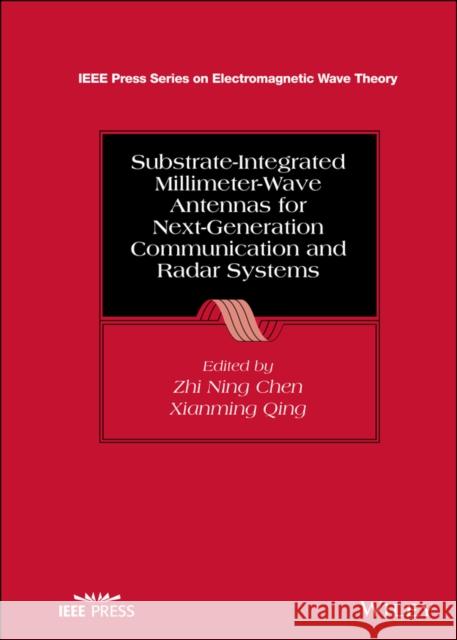Substrate-Integrated Millimeter-Wave Antennas for Next-Generation Communication and Radar Systems » książka



Substrate-Integrated Millimeter-Wave Antennas for Next-Generation Communication and Radar Systems
ISBN-13: 9781119611110 / Angielski / Twarda / 2021 / 320 str.
Substrate-Integrated Millimeter-Wave Antennas for Next-Generation Communication and Radar Systems
ISBN-13: 9781119611110 / Angielski / Twarda / 2021 / 320 str.
(netto: 519,16 VAT: 5%)
Najniższa cena z 30 dni: 538,44
ok. 30 dni roboczych.
Darmowa dostawa!
Editor biographies - to followContributorsPreface to followChapter 1 Introduction to Millimeter Wave Antennas1.1 Millimeter Waves1.2 Propagation of Millimeter Waves1.3 Millimeter Wave Technology1.3.1 Important Features1.3.2 Major Modern Applications1.4 Unique Challenges of Millimeter Wave Antennas1.5 Briefing of State-of-the-Art Millimeter Wave Antennas1.6 Implementation Considerations of Substrate Integrated Millimeter Wave Antennas1.6.1 Fabrication Processes and Materials of the Antennas1.6.2 Commonly Used Transmission Line Systems for Antennas1.7 Note on Losses in Microstrip-lines and Substrate Integrated Waveguides1.8 Update of Millimeter Wave Technology in 5G and Beyond1.9 SummaryReferencesChapter 2 Measurement Methods and Setups of Antennas at 60-325-GHz Bands2.1 Introduction2.1.1 Far-field Antenna Measurement Setup2.1.2 Near-field Antenna Measurement Setup2.2 Sate-of-the-art mmW Measurement Systems2.2.1 Commercially Available mmW Measurement Systems2.2.2 Customized mmW Measurement Systems2.3 Considerations for Measurement Setup Configuration2.3.1 Near-field versus Compact Range2.3.2 RF System2.3.3 Interface Between the RF Instrument and AUT2.3.4 On-Wafer Antenna Measurement2.4 mmW Measurement Setup Examples2.4.1 60-GHz Antenna Measurement Setup2.4.2 140-GHz Antenna Measurement Setup2.4.3 270-GHz Antenna Measurement Setup2.5 SummaryReferencesChapter 3 Substrate Integrated mmW Antennas in LTCC3.1 Introduction3.1.1 Unique Design Challenges and Promising Solutions3.1.2 SIW Slot Antennas and Arrays in LTCC3.2 High-gain mmW SIW Slot Antenna Arrays in LTCC3.2.1 SIW Three-Dimensional Corporate Feed3.2.2 Substrate Integrated Cavity Antenna Array at 60 GHz3.2.3 Simplified Designs and High-order-mode Antenna Array at 140 GHz3.2.4 Fully Substrate Integrated Antennas at 270 GHz3.3 SummaryReferencesChapter 4 Broadband Metamaterial-Mushroom Antenna Array at 60-GHz Bands4.1 Introduction4.2 Broadband Low-Profile CRLH-Mushroom Antenna4.2.1 Working Principle4.2.2 Impedance Matching4.3 Broadband LTCC Metamaterial-Mushroom Antenna Array at 60 GHz4.3.1 SIW Fed CRLH-Mushroom Antenna Element4.3.2 Self-Decoupling Functionality4.3.3 Self-Decoupled Metamaterial-Mushroom Subarray4.3.4 Metamaterial-Mushroom Antenna Array4.4 SummaryReferencesChapter 5 Narrow-Wall-Fed Substrate Integrated Cavity Antenna at 60 GHz5.1 Introduction5.2 Broadband Techniques for Substrate Integrated Antennas5.2.1 Enhancement of Impedance Matching for SIW Antennas5.2.2 Multi-Mode Substrate Integrated Cavity Antennas5.2.3 Substrate Integrated Cavity Backed Slot Antenna5.2.4 Patch Loaded Substrate Integrated Cavity Antenna5.2.5 Travelling-wave Elements Loaded Substrate Integrated Cavity Antenna5.3 SIW Narrow Wall Fed SIC Antennas at Ka- and V-bands5.3.1 SIW Narrow Wall Fed SIC Antenna5.3.2 SIW Narrow Wall Fed SIC Antenna Array at 35 GHz5.3.3 60-GHz SIW Narrow Wall Fed SIC Antenna Array5.4 SummaryReferencesCHAPTER 6 Cavity-Backed SIW Slot Antennas at 60 GHz6.1 Introduction6.2 Operating Principle of the Cavity-backed Antenna6.2.1 Configuration6.2.2 Analysis of the Backing-cavity6.2.3 Design of the Backing-cavity6.3 Cavity-backed SIW Slot Antenna6.3.1 Feeding techniques6.3.2 The SIW Backing-cavity6.3.3 Radiating Slot6.4 Types of SIW CBSAs6.4.1 Wideband CBSAs6.4.2 Dual-band CBSAs6.4.3 Dual-polarized and Circularly Polarized CBSAs6.4.4 Miniaturized CBSAs6.5 CBSA Design Examples at 60 GHz6.5.1 SIW CBSA with Different Slot WLR6.5.2 Array Examples with Different WLRs of Slot6.6 SummaryReferencesChapter 7 Circularly Polarized SIW Slot LTCC Antennas at 60 GHz7.1 Introduction7.2 Key Techniques of mmW CP Antenna Array7.2.1 Antenna Element Selection7.2.2 AR Bandwidth Enhancement Methods7.3 Wideband CP LTCC SIW Antenna Array at 60 GHz7.3.1 Wideband AR Element7.3.2 Isolation Consideration7.3.3 Experiment Results and Discussion7.4 SummaryReferencesChapter 8 Gain Enhancement of LTCC Microstrip Patch Antenna by Suppressing Surface Waves8.1 Introduction8.1.1 Surface waves in microstrip patch antennas8.1.2 Surface waves effects on microstrip patch antenna8.2 State-of-The-Art Methods for Suppressing Surface Waves in Microstrip Patch Antennas8.3 Microstrip Patch Antennas with Partial Substrate Removal8.3.1 Technique of partial substrate removal8.3.2 60-GHz LTCC antenna with partial substrate removal8.4 SummaryReferencesChapter 9 Substrate Integrated Antennas for Millimeter Wave Automotive Radars9.1 Introduction9.1.1 Automotive Radar Classification9.1.2 Frequency Bands for Automotive Radars9.1.3 Comparison of 24-GHz and 77-GHz Bands9.1.4 Antenna System Considerations for Automotive Radar Sensors9.1.5 Fabrication and Packaging Considerations9.2 Sate-of-the-Art Antennas for 24-GHz and 77-GHz Automotive Radars9.2.1 Selected state-of-the-Art Antennas for 24-GHz Automotive Radars9.2.2 Selected state-of-the-Art Antennas for 77-GHz Automotive Radars9.3 Single-layer SIW Slot Antenna Array for 24-Ghz Automotive Radars9.3.1 Antenna Configuration9.3.2 Slot Array Design9.3.3 Feeding Network Design9.3.4 Experiment Results9.4 Transmit-array Antenna for 77-Ghz Automotive Radars9.4.1 Unit Cell9.4.2 Four-beam Transmit-array9.4.3 Results9.5 SummaryReferencesChapter 10 Sidelobe Reduction of Substrate Integrated Antenna Arrays at Ka-Band10.1 Introduction10.2 Feeding Networks for Substrate Integrated Antenna Array10.2.1 Series Feeding Network10.2.2 Parallel/Corporate Feeding Network10.2.3 Flat Lens/Reflector-Based Quasi-Optics Feeding Network10.2.4 Power Dividers10.3 SIW Antenna Arrays with Sidelobe Reduction at Ka-Band10.3.1 Double-layer 8×8 SIW Slot Array10.3.2 16×16 Monopulse SIW Slot Array10.4 SummaryReferencesChapter 11 Substrate Edge Antennas11.1 Introduction11.2 State-of-the-Art11.2.1 End-fire SEAs11.2.2 Leaky-wave SEAs11.3 Tapered Strips for Wideband Impedance Matching11.3.1 Tapered Triangular Strips11.3.2 Tapered Rectangular Strips11.4 Embedded Planar Lens for Gain Enhancement11.4.1 Embedded Metallic Lens11.4.2Embedded Gap Lens11.5 Prism Lens for Broadband Fixed-Beam Leaky-wave SEAs11.6 Summary References
Zhi Ning Chen currently is the Professor of the Department of Electrical and Computer Engineering, National University of Singapore, and the Founder of the Advanced Research and Technology Innovation Center. Dr Chen received the B.Eng., M.Eng., and Ph.D. degrees in electrical engineering from the Institute of Communications Engineering, China, and the second Ph.D. degree from the University of Tsukuba, Tsukuba, Japan. Dr Chen is the Fellow of IEEE (2007) and the Fellow of Academy of Engineering of Singapore (2019).Xianming Qing is currently with Institute for Infocomm Research (I²R), Agency for Science, Technology and Research (A*STAR), Singapore, and holding the position of senior scientist. Dr Qing received the B.Eng. from University of Electronic Science and Technology of China, P. R. China, in 1985 and Ph.D. from Chiba University, Japan, in 2010. Dr. Qing is the Fellow of IEEE (2019).
1997-2025 DolnySlask.com Agencja Internetowa
KrainaKsiazek.PL - Księgarnia Internetowa









